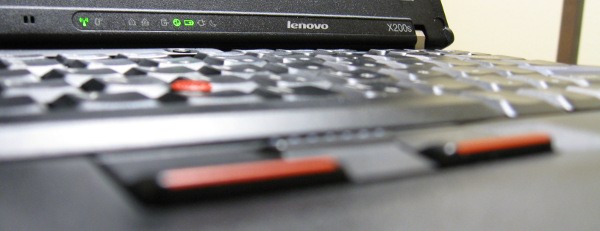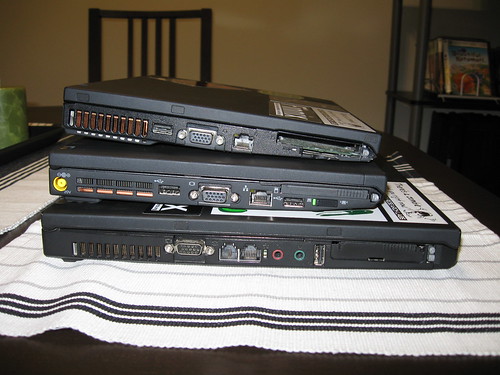Lenovo ThinkPad X200s

My first ThinkPad was a T60 14.1”. I had heard good things about the T40 series from friends, and was in the market for a new laptop, as I have a tendency to go through about one laptop per year. The T60 was released shortly after IBM sold the ThinkPad line to Lenovo, and you got that sense by looking at it. The main logos on the cover and keyboard tray still said “IBM ThinkPad”, and the only place Lenovo was mentioned was next to the status lights and on the underside stickers.
I loved it. It was light by 14” laptop standards (5 lbs with a standard 6-cell battery) and very well designed. The LCD cover had an internal magnesium coating to prevent press damage from the top, and the entire laptop had an internal roll cage that increased stiffness and decreased the likelihood of damage if it were dropped. Indeed, I did drop it a few times, and it still looks new, even today. I could pick it up with the display open and hold it with three fingers on the corner of the palm rest, and the chassis would not flex at all. And a trademark of the ThinkPad line, the keyboard had no flex whatsoever, with a deep travel for a laptop keyboard.
Of course, you pay for quality, and the ThinkPad line isn’t exacly known for being inexpensive. Unfortunately, I cheaped out on the processor and picked the lowest one (a T5500 IIRC), and that ended up being the impetus to replace. After about a year, I bought a new ThinkPad. (Remember, the T60 still basically felt new at that point. On a normal laptop I go through, it’s usually falling apart within a year.)
I went with the X61, thinking I’d give the X series a shot. A 12” laptop with a full-sized keyboard, 10 hour battery life with a 9-cell battery and only 3.2 lbs? Sounded great! Sadly, it didn’t turn out as well. The keyboard’s letter/number keys were indeed the same size as the T60, but the side keys were chopped off to about half-size. The keyboard itself flexed (not as bad as a normal laptop, but still noticeable), the travel was shallower than the T60, and the key presses themselves would wear out, especially when hit from the corners (backspace and \ were the worst). In 2 years, I had RMA’d the keyboard twice.
The entire build quality wasn’t great either. It did not include a magnesium screen backing or a roll cage, and the entire chassis would flex a bit. The PCCARD slot cover broke off, and plastic pieces broke off the corners during a fall. One of the hinge clasps broke off (though only one, so it still closes and stays shut correctly). The palm rest would get rather hot. Still, it survived 2 years. The final straw wasn’t actually the laptop falling apart (it was still decently usable), it was the battery when it could no longer last for more than 30 minutes. I don’t blame Lenovo or the battery for that; 2 years of active battery use is a pretty good lifetime. But the idea of paying $100 for a replacement battery got me looking at whole laptop replacements.
With trepidation, I started looking at Lenovo’s site. They’ve added some more lines since the acquisition, but since I’m more interested in build quality than performance or screen size or whatnot, I didn’t know how well a “W” or “R” or “IdeaPad” would stand up to the test of… me. The T201 and X201 series had just been released, but were rather expensive. I remembered the Lenovo Outlet site and went there, and found a bunch of T200 and X200 laptops that were on clearance. Some of them were refurbished or unopened returns, but most were new order cancels. After a little browsing, I came across an X200s that had everything I wanted if I were to custom configure one myself: C2D SL9400 (one down from top of the line), 4GB memory (maxed out), no trackpad, LED-lit LCD display, all-Intel chipset configuration, upgraded WiFi chipset, Bluetooth, cheapest hard drive (I’d just swap it out with my SSD), and 9-cell battery. And it was $820, over $1000 off retail (a similarly configured X201 with the proper coupons could knock it down to about $1500). Again, with hesitation, I ordered it.
Lenovo, you are forgiven. And I’m sorry for any offhand “Chinese quality” remarks I may have made in the last 2 years.
I’ve been using it for 3 days now, and I can honestly say this is the best laptop I’ve ever had. Every gripe I mentioned about the X61 has been fixed with the X200s. The keyboard is, as far as I can feel, identical to the T60. Same travel, same sized side keys, no flex. The top is reinforced with a carbon fiber composite, and the laptop once again includes a roll cage, so everything is sturdy. As touted by Lenovo, the internal thermals have been reworked to cool down the palm rest and keyboard, and you can feel it. The SL9400, despite being a low-voltage CPU, is plenty fast. Hell, they even brought back the red IBM stripes on the mouse buttons that were removed from the T61/X61.
The X200s is a “more mobile” version of the X200. It uses low-voltage CPUs and a LED backlit screen to crank out even more battery life, 10 to 12 hours on a 9-cell battery. (By the way, even though the 9-cell batteries do hang off the back of the laptop, I found that actually makes a nice grip for walking while the display is opened.) With a 9-cell battery, the laptop is still only 3.4 lbs, .2 lbs more than the X61 with a 9-cell battery. And the X200s includes a composite top and roll cage, while the X200 doesn’t.
(From bottom to top: T60 14”, X200s, X61)
The 12” (16:10) X200s with its full size keyboard is about as wide as the 14” (4:3) T60, but the same depth as the 12” (4:3) X61. Working on a 16:10 display is a little odd after all this time, but it’s easy to adjust to. It’s thicker than an X301 (or its main rival, the MacBook Air), but still thinner than most other laptops, including the T series.
One thing that is really nice about ThinkPads is the accessory consistency. All three laptops use the exact same power supply (65W, 20v, same connector). All three use the same SATA drive sled. Because of that, I was able to take my aftermarket SSD (OCZ Vertex 60GB) out of the X61 and immediately put it in the X200s. Kudos to Ubuntu as well, my 10.04 installation went from X61 to X200s perfectly without any user intervention. Display resolution changed, new wireless card was recognized, Bluetooth was set up.
There is… one downside to the X200s. The color balance on the LED LCD is atrocious. Many LCD manufacturers weight the color distribution toward blue (the practice is known as “showroom syndrome” since more blue makes the picture look more “vibrant” in a showroom), but this was just plain horrible. Unfortunately, this being a laptop, there are no hardware color adjustment controls. Thankfully, I have the tools to correct for this, namely a Spyder2 at work. (I mentioned this while reviewing a Dell monitor.) Gnome now also has a color manager that supports the Spyder2, so I was able to profile the display completely within Ubuntu. I was able to get it to a decent balance, and published the ICC profile. So if you also have an X200s with LED backlighting, I’d recommend this ICC profile. Unless you like blue.

